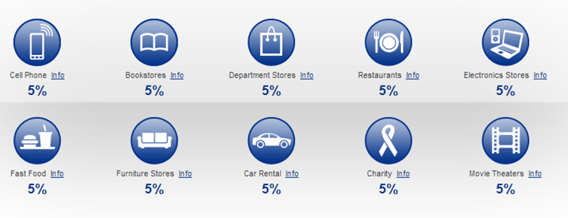NOTICE: This post references card features that have changed, expired, or are not currently available
A long, long time ago, in a galaxy… uh, well, this one… credit card companies discovered that they could win customers and keep them loyal by offering rewards. In the early days, 1 airline mile per dollar or 1% cash back was incentive enough. Over time, though, 1 point per dollar became the minimum starting point. Credit card companies had to offer more. Many offered bonuses for signing up. That was great for attracting new customers, but did little to keep them loyal. Some increased earnings across the board. Some offered big spend bonuses (e.g. “10,000 bonus miles with $25,000 annual spend!”). And, some offered category bonuses. In great big font, ads would encourage consumers to…
Earn 2X, 3X, or even 5X!
… within certain specified categories.
Credit card companies often lose money on spend made within category bonus categories. Take, for example, the no-fee US Bank Cash+ card that offers 5% cash back within certain categories. Each quarter, cardholders can choose two of the available categories such as those pictured below (not pictured: fitness centers and sporting good stores). 5% cash back is limited to $2K spend per quarter:
I don’t know exactly how much US Bank earns from credit card processing fees on these transactions, but I’m absolutely sure it is far less than 5%. Offers like these are loss leaders. Credit card companies hope consumers will choose their cards for their amazing rewards and will use them for all of their purchases. These companies expect to earn a profit based on an average mix of spending across both bonus and non-bonus categories, and from consumers who pay fees and interest charges month to month.
Some people stay ahead of the game by avoiding fees and interest charges (advice interruption: always pay our credit card bill in full every month!) and by using different cards for different expenses. For example, use your Cash+ card for 5% cash back at department stores and restaurants. Use your Chase Ink card for 5X with office supplies, cable, internet, and phone. You get the idea (see “Best Category Bonuses” for many more examples). Let’s call this practice Category Bonus Optimization. Its not exactly fun keeping a half dozen credit cards on hand to maximize rewards, but it becomes second nature once you get used to it.
Of course, credit card companies don’t like this. If you only use their cards within loss leader categories, and you always pay your bill in full each month, and you avoid all other fees, then having you as a customer costs the credit card company money. Most credit card companies have limited their losses by capping bonus spend in various ways (e.g. Cash+ limits 5% cash back spending to $2K per quarter, Amex Blue Cash Preferred earns 6% cash back at US Supermarkets stores, up to $6K per year (then 1%), etc.). Still, they’ve failed with their main objective: to have you use their cards for all spend across the board.
Enter Amex EveryDay cards
American Express’ new EveryDay cards, launching April 2, are different. Like many other American Express cards, they earn Membership Rewards points. And, like countless other cards, they offer bonus categories (for full details see “Amex’s powerful new EveryDay cards”). What makes these cards unique is that they offer a monthly bonus based on how often you use the card. With the no fee EveryDay card, consumers earn a 20% bonus every billing cycle in which they make 20 or more purchases. And, with the $95 per year EveryDay Preferred card, consumers earn a 50% bonus every billing cycle in which they make 30 or more purchases.
In my opinion, the idea of rewarding frequent spend was a stroke of genius. At once, they made the cards rewarding enough to be legitimate contenders for wallet share and they added a serious disincentive to practice Category Bonus Optimization. Take the $95 EveryDay Preferred card, for example. It offers 3X at US supermarkets (up to $6K spend per year), 2X at US gas stations, and 1X everywhere else. And, it offers a 50% bonus each billing cycle in which you make 30 or more purchases. For most people I’d guess that 30 purchases a month is easy to achieve if you use the card everywhere. However, if you use the card only for groceries and gas, the goal of reaching 30 purchases becomes a real challenge. Sure, we’ll start seeing people checking out at the grocery store one item at a time (if this is your plan, we hate you already), but most people won’t want to bother. My guess is that many who practice category bonus optimization today will be happy to thin out their wallet in exchange for a single “every day” card that offers competitive rewards across the board and fantastic rewards within common spend categories (groceries and gas).
Going forward
As I pointed out in the post “Amex’s powerful new EveryDay cards,” the new cards are extremely rewarding if your goal is to earn airline miles (transferred from Membership Rewards points). However, there are better options for earning cash back or other rewards. Those who practice category bonus optimization today can keep doing so. Whether or not they choose to add the EveryDay cards to the mix depends on their preference for earning miles over cash back and their willingness to overcome the transaction minimums required for bonuses. Personally, I can imagine doing both: get the EveryDay Preferred card for my wife (here, use this everywhere), but keep a half dozen cards in my wallet for myself.
A big question is how competitors will respond. If the new EveryDay cards are a big hit (and I’m betting they will be), the other credit card companies will have to fight back. I think it will be fascinating to see what Chase, Barclaycard, and others do to encourage consumers to use their cards for all spend rather than selected spend. And, will they do something to prevent the one item at a time checkout scenario? Here’s to hoping so!






[…] recently detailed how American Express hopes to win the category bonus war (see “Amex’s EveryDay weapons in the category bonus war”). Their goal is to incentivize consumers to use their cards for all daily spend. […]
It’s almost as if AMEX hired a blogger to design this card. I’m counting on you, FM, to put it to use.
Problem with the wife ‘use this card everywhere’ is that this is an Amex. Need V/MC for that, in my experience.
I’m sure someone will come up w/ a scheme to manufacture 10+ trx’s in a day, so they don’t really have to keep track 🙂
Well, since number hyphen number codes as groceries for Amex you can easily hit the 30 times per month AND max out the category in a month or two. Then just use it for daily redbull or whatever, maybe fast food to hit 30X going forward and at gas stations for the 3X. Seems like a good deal actually.
And yes its apparently $95 for the preferred.
Are you sure it codes that way with Amex? That’s very interesting!
That is very interesting information!
Pretty sure the Preferred version comes with a $95 annual fee, not $75.
Thanks. Fixed.
if only Amex scales back their FR then the spending will be free and clear. otherwise the FR just hangs over head and limits spending habit.
The Pointguy drops you in his blog roll, ehh
Huh. I didn’t notice that. Bummer.
Huh. I didn’t notice that. Bummer.
I think you’re completely underestimating your readership’s capacity for gaming the system. Like Rob pointed out, and your grocery store self-checkout example it’d be trivial to bang out the monthly 30-swipe requirement in about 10 minutes.
I have no doubt that many of my readers will game the 30 transaction minimum. My point was more directed to consumers at large.
“And, with the $75 per year EveryDay Preferred card, consumers earn a 50% bonus every billing cycle in which they make 30 or more purchases.”
Just as a heads up, the EveryDay Preferred is $95 a year.
Thanks. Fixed
30 swipes will be easy at Amazon with $0.15 gift certificates.
[…] starting point. Credit card companies had to offer more. Many offered bonuses for signing up. That was great for attracting new customers, but did little to keep them loyal. Some increased earnings across the board. Some offered big spend Read full article […]
In normal usage, I think hitting 30 swipes is not a no-brainer for me. I would probably have to juice it by setting my EasyPass (automatic toll-pay system) to recharge very frequently, or buying my MetroCard (subway & bus fare card) a dollar at a time.
.
In practice, I think the frequency spend boost is going to be attractive to but unmet by many people who sign up for this card.
The Chase Exclusives program let people with Freedom cards get an extra 10 UR points per transaction, and after years of abuse (buying stamps, small Amazon Payments transactions) they pulled it.
That’s true. Amex’s plan is different because it doesn’t reward each transaction. It just gives a fixed percent award for reaching a transaction count. So, there’s much less opportunity for abuse.
So its in essence a mr card of 3.5x at supermarkets and 2.5x at gas stations. In addition to the cap, Ms at supermarkets can be hard since a lot only take cash for gc and requires the extra step of wally world. 30 transactions is trivial via A.P. or ebay. Am I missing something?
Actually 4.5X at supermarkets and 3X at gas stations assuming the bonus really covers all points earned (I guess we’ll find out for sure soon).